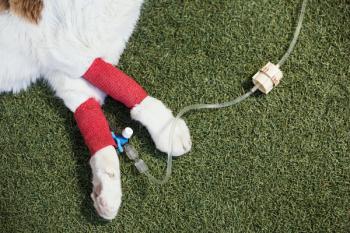
Using sublingual immunotherapy to treat atopic dermatitis in canine veterinary patients
Consider oral allergen administration when treating patients with this skin condition to reduce reaction risk and achieve an optimal result.
The practice of desensitizing an allergic patient with sublingual drops of allergens instead of utilizing subcutaneous injections has been available in human medicine for many years, and it recently obtained FDA approval for the treatment of allergic rhinitis to certain grasses. Over the past several years, there has been more interest in and research done on this modality in veterinary medicine, giving the practitioner who treats atopic patients with immunotherapy a welcome additional option. Recent studies have demonstrated that the treatment is safe, and I personally find it effective in my own patients.
(GETTY IMAGES/ANZELETTI)
With so many pharmaceutical options available to the practitioner for the treatment of atopic dermatitis, one could question the recommendation of a complex process such as allergen-specific immunotherapy. Immunotherapy offers several advantages over pharmaceutical therapies. First and foremost, allergen-specific immunotherapy is the only treatment that can change the natural course of the disease2 and is the only effective modality that is not a drug, making this an attractive option for many clients. In humans, immunotherapy, whether given by injection or sublingual routes, has been found to arrest the development of hypersensitivities to additional allergens.2,3 This can be especially important in younger veterinary patients, because without immunotherapy, the patients' clinical signs attributable to allergies have a tendency to get worse as pets age. The continued development and worsening of clinical signs is recognized in atopic human beings as well.
Therefore, when a young patient has been confirmed to have atopic dermatitis and is suffering for more than a few months of the year, allergy testing and immunotherapy of some form should be recommended. Despite the fact that corticosteroids, cyclosporine and oclacitinib can reduce or control pruritus, they do not stop the progression of the disease or the development of additional allergies, which can lead to an increase in pruritus and an increase in medication dosages needed to control these clinical signs. In addition, these medications may have adverse short- or long-term effects and can be expensive for the pet owner, especially for those with medium or large dogs. The International Task Force on Atopic Dermatitis recommends that, when feasible, implementation of allergen-specific immunotherapy as an intervention to prevent further recurrence of clinical signs of atopic dermatitis should be recommended.4
Formulation: sublingual versus injectable
Sublingual immunotherapy is not as simple as taking allergens formulated for injection and administering them orally. Several formulation differences exist, starting with the fact that the allergens are typically compounded or mixed with glycerin instead of saline. In people, it is known that the concentration of sublingual allergens needs to be higher than the typical dose given by subcutaneous administration. Most companies offering injectable immunotherapy now offer their allergens in sublingual formulation as well. What is not different between sublingual and injectable protocols is the importance of correlating allergy test results with the patients' history of pruritus and patterns of exposure.2,3,5 All clinicians utilizing immunotherapy should monitor pollen counts regularly to get a sense of what is actually relevant and significant, while also monitoring each patient for what seasons or activities (such as a trip to the dog park) trigger flares, and then correlate this information with the test results. If the clinician is not prepared to take this active role in the contents or recipe of the allergen, then the patient should be referred to a specialist or clinician who is more well-versed in the science of aerobiology and has the time and interest to better monitor such details.
Benefits of sublingual immunotherapy
One obvious benefit of sublingual versus injectable immunotherapy is the fact that needles are not involved. Some needle-phobic clients (and patients) now have the ability to easily administer immunotherapy without the physical and emotional trauma of an injection. Because glycerin can have a slightly sweet taste, most dogs do not mind the administration of the product, which ideally is placed below the tongue and behind the mandibular incisors. Another significant advantage of sublingual over injectable immunotherapy is the higher margin of safety.6,7 Patients that experience adverse reactions to allergen injections should be considered excellent candidates for sublingual immunotherapy.6 In my practice, we've had several patients that exhibited anaphylaxis in response to either the intradermal allergy test or their injectable allergens that have not just tolerated but responded well to sublingual immunotherapy.
Another reason to consider sublingual immunotherapy is the fact that placement of the allergen sublingually can result in a different, possibly more favorable, immunological response.3,7,8 Patients that have failed to respond adequately to injectable immunotherapy may respond well to sublingual. The first patient I personally started on sublingual immunotherapy had been receiving injectable immunotherapy for nearly two years with only marginal improvement. The patient experienced significant improvement after less than 30 days of sublingual immunotherapy.
In both human and veterinary medicine, the precise mechanisms related to induction of immune tolerance by sublingual immunotherapy remain unclear. However, contact of the allergen with antigen-presenting cells in the oral mucosa is likely a critical factor. Mucosal Langerhans cells can capture the allergen and transport it to local lymph nodes, which may favor the induction of T lymphocytes that suppress the allergic response. In addition, the production of blocking IgG4 antibodies and the involvement of mucosal B lymphocytes appear to play a role. Additional data suggest that sublingual immunotherapy may increase interleukin-10, which has a clear role in suppressing the allergic immune response.8,9
While maintenance allergen injections are usually administered every one to three weeks, sublingual immunotherapy requires daily administration-even twice-daily administration with some patients or protocols. Although this may be considered a drawback of sublingual compared to injectable immunotherapy, the owner might remember a daily routine more easily, resulting in higher compliance. In addition, the consequence of missing one daily dose is less significant compared with missing an injection that was scheduled for every one to three weeks. Even though the efficacy of sublingual immunotherapy has been definitively proven in humans,1,3,5 we are still awaiting double-blind, placebo-controlled studies in our animal patients. Nevertheless, the findings of many experienced, busy dermatologists, including myself, are that the efficacy of sublingual immunotherapy appears to be as good as that seen with injectable immunotherapy; for some patients, their response is superior to results achieved from injectable immunotherapy.
Dosing
What is not yet known is the "optimal" protocol regarding dosing schedules, concentration and frequency. Dermatologists may never agree on one standard dosing protocol for injectable or sublingual immunotherapy, but they will agree that different patients require different dosing schedules and allergen levels to achieve optimal results. Companies that provide allergens in sublingual form will include a dosing schedule and possibly different vials of different dilutions. These schedules, which include an induction or "uploading" schedule, are directly derived from injectable immunotherapy schedules. Besides delaying the benefits derived from more potent allergen concentrations, these diluted vial schedules can be confusing to clients. There is growing evidence in human medicine that the uploading schedules in which diluted vials are used in the induction phase of immunotherapy are not necessary; several published protocols in human medicine show safety and efficacy of starting with concentrated vials.3,7
In our practice, we do not use a diluted vial, but instead we start the first day with the more concentrated allergen vial averaging 20,000 protein nitrogen units (PNU) per milliliter (PNU/ml). We feel that the additional safety of sublingual immunotherapy also lends itself to this more rapid protocol schedule so that our patients may respond more quickly. In the 12-month period from May 2013 through April 2014, the doctors at Dermatology for Animals have placed 910 patients on sublingual immunotherapy with the starting recommendation of 0.05 ml (one pump) of allergen administered once daily. Of these patients, four (0.44 percent) have experienced hives of the trunk, and one experienced vomiting. In one of these patients, the hives subsided and did not recur with subsequent dosing of the immunotherapy. Three of these patients tolerated the sublingual allergen when it was diluted 1:1 with glycerin, resulting in a 10,000 PNU/ml concentration. All three of these patients are currently doing well. A notable adverse event rate of less than half of 1 percent is certainly an admirably safe protocol, especially when compared with the alternative therapeutic options-and again, this was without using diluted vials and an induction schedule. There have been a few more cases (approximately 15) in which the owners believed their dogs exhibited temporary (less than one minute) oral or facial scratching after the allergen was administered. When human patients react to sublingual immunotherapy with oral itch, one recommendation is to place the allergens in the vestibule of the oral cavity instead of sublingually, which might circumvent or minimize mast cell-related side effects of this type of immunotherapy.8
When to use it
When starting a new patient on allergen-specific immunotherapy, I currently recommend the sublingual route as the initial protocol and will switch to injectable immunotherapy only if the patient is not achieving a positive response after eight months. Like many aspects of allergy and immunotherapy, the adage that "one size does not fit all" applies, and fine tuning of sublingual immunotherapy may be necessary in some patients just as it is with injectable protocols. Whereas some patients may require one pump 50 µl (0.05 ml), some patients respond more favorably to 0.1 ml daily, while others 0.05 ml twice daily. In human medicine, published protocols range from twice-daily dosing to once-weekly dosing and from year-round administration to preseasonal (starting one month before symptoms start and stopping at the start of the allergy season), coseasonal (start and end with the pollen season) or variations of the above. My own atopic dog is well controlled on an average of four doses per week.
In conclusion, the option to administer allergens in a sublingual format is an exciting treatment modality. Its higher safety level, ease of administration and potentially equal or better efficacy for many patients compared with conventional immunotherapy should lead to sublingual immunotherapy being recommended early as a treatment option for the atopic patient.
References:
1. U.S. Food and Drug Administration. FDA approves first sublingual allergen extract for the treatment of certain grass pollen allergies. Available at:
2. Esch RE, Portnoy J. Allergen immunotherapy. Curr Allergy Asthma Rep 2001;1:491-497.
3. Lombardi C, Incorvaia C, Braga M, et al. Administration regimens for sublingual immunotherapy to pollen allergens: what do we know? Allergy 2009;64:849-854.
4. Olivry T, DeBoer DJ, Favrot C, et al. Treatment of canine atopic dermatitis: 2010 clinical practice guidelines from the International Task Force on Canine Atopic Dermatitis. Vet Dermatol 2010;21:233-248.
5. Cox L, Nelson H, Lockey R, et al. Allergen immunotherapy: A practice parameter third update. J Allergy Clin Immunol 2011;127(Suppl 1):S1-55.
6. DeBoer DJ, Morris M. Multicentre open trial demonstrates efficacy of sublingual immunotherapy in canine atopic dermatitis. Vet Dermatol 2012;23(Suppl 1):65-66.
7. Rodriguez F, Boquete M, Ibanez MD, et al. Once daily sublingual immunotherapy without updosing--A new treatment schedule. Int Arch Allergy Immunol 2006;140:321-326.
8. Novak N, Bieber T, Allam JP. Immunological mechanisms of sublingual allergen-specific immunotherapy. Allergy 2011;66:733-739.
9. Akdis CA, Barlan IB, Bahceciler N, et al. Immunological mechanisms of sublingual immunotherapy. Allergy 2006;61(Suppl 81):11-14.
Newsletter
From exam room tips to practice management insights, get trusted veterinary news delivered straight to your inbox—subscribe to dvm360.





